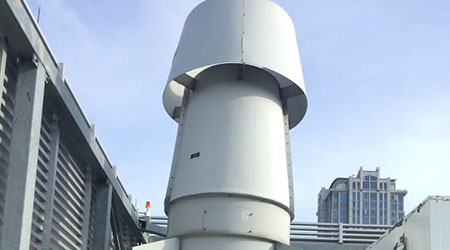CHALLENGE: University Health network (UHN) is Canada's largest research hospital which operates four major hospitals and one teaching institute: Toronto Western Hospital, Toronto General Hospital, Princess Margret Cancer Centre, Toronto Rehabilitation Institute and The Michener Institute.
An Aircuity platform was initially installed in the Princess Margaret Cancer Research Tower in the MaRS Discovery District. The platform's DCV control of the labs' air supply saved approximately $800,000. UHN was happy with the savings but at the same time they knew more could be done.
An important compliment to the platform in lab buildings is the exhaust fan application. PMCRT was designed with twelve 40HP fans in groups of three (4 triplexes) serving each quadrant of the lab floor plate of the building.
Before the exhaust fan project was implemented the exhaust system was designed to produce a continuous discharge plume with an exit velocity of 3,000 ft/min. Not only was there a lot of clean outside air being blown up through the fans but many times the air coming from the fume hoods was also clean. UHN worked with AirGenuity to implement the exhaust fan application for maximum savings in the building.
New variable frequency drives were installed enabling fan speeds to be ramped down or up according to building needs. Also, a wind tunnel study was done to ensure a safe beginning fan horsepower that prevents the emissions from reaching any of UHN's HVAC rooftop intakes and those of their surrounding neighbors in the tight downtown area. The study determined that beginning fan HP could be reduced from 480 down to 100HP.
When the system detects any contamination in the exhaust plenum, fan speeds are ramped back up to full speed until the air is clean again. This ensures energy savings but also a healthy space for researchers and occupants of surrounding buildings.
At the same time that the exhaust fan application was being installed at PMCRT, University Health Network installed Aircuity to optimize supply and exhaust air in the Krembil Research Tower as well.
RESULTS
In order to confirm savings, UHN conducted pre-retrofit measurements using the new system and running the VFDs at 100 percent speed and then compared that to the power used once the exhaust fan application was implemented. UHN then extrapolated those savings to get annual savings of 1,550,000 kWh (equivalent to 160 houses in Ontario) and electric peak demand savings of 111.7 kW (equivalent to running 1,400 flat screen TVs simultaneously).
This equals a cost savings of $200,000 annually. When coupled with savings from the previous lab project in PMCRT, the reduction in utility costs equals approximately $1,000,000 annually.
For additional information on the company and its solutions, please visit: www.aircuity.com.

 UF Health Hospitals Rely on Green Globes to Realize Their Full Potential
UF Health Hospitals Rely on Green Globes to Realize Their Full Potential How Healthcare Facilities Can Be Truly Disaster-Resilient
How Healthcare Facilities Can Be Truly Disaster-Resilient TriasMD Breaks Ground on DISC Surgery Center for San Fernando Valley
TriasMD Breaks Ground on DISC Surgery Center for San Fernando Valley Bigfork Valley Hospital Falls Victim to Data Breach
Bigfork Valley Hospital Falls Victim to Data Breach AI-Driven Facilities: Strategic Planning and Cost Management
AI-Driven Facilities: Strategic Planning and Cost Management